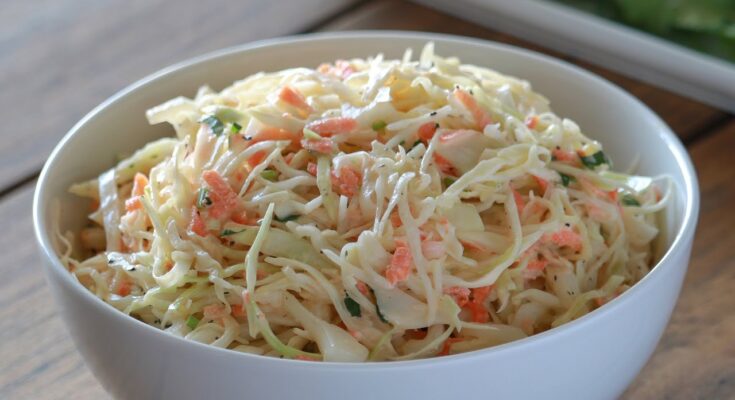Traditional Coleslaw Recipe: Coleslaw is a classic side dish loved for its crunchy texture and creamy, tangy dressing. It’s the perfect accompaniment to BBQ, sandwiches, and fried foods, adding a refreshing contrast to rich, savory dishes. While store-bought coleslaw is convenient, nothing beats the fresh and homemade version, where you can adjust the flavors to your preference.
This guide will walk you through the process of making a traditional coleslaw from scratch, ensuring the perfect balance of flavors and textures.
Ingredients Required for Traditional Coleslaw
Main Ingredients
To make a traditional coleslaw, you’ll need:
- Cabbage – Green cabbage is the most commonly used, but adding a bit of red cabbage gives color and extra crunch.
- Carrots – These add natural sweetness and a pop of color.
- Onion (Optional) – Some recipes include finely chopped onions for an extra kick of flavor.
Dressing Ingredients
The dressing is what makes coleslaw truly delicious. Here’s what you’ll need:
- Mayonnaise – The creamy base of the dressing.
- Vinegar – Apple cider vinegar or white vinegar adds the signature tangy flavor.
- Sugar – Just a touch to balance the tanginess.
- Mustard – Adds a little depth of flavor.
- Salt & Pepper – For seasoning.
Kitchen Tools Needed
Before you start, gather these essential tools:
- Cutting board and sharp knife – To shred the cabbage.
- Grater or food processor – For finely shredding the carrots.
- Mixing bowls – For mixing the vegetables and dressing separately.
- Whisk or spoon – To blend the dressing smoothly.
Step-by-Step Guide to Making Traditional Coleslaw
Step 1: Preparing the Vegetables
- Shred the Cabbage – Remove the outer leaves, cut the cabbage in half, and remove the core. Use a sharp knife, food processor, or mandoline slicer to shred the cabbage into thin strips.
- Grate the Carrots – Peel and grate them finely using a box grater or food processor.
- Chop the Onion (Optional) – If using, finely chop it to avoid overpowering the dish.
Step 2: Making the Dressing
- In a mixing bowl, combine:
- ½ cup mayonnaise
- 2 tablespoons apple cider vinegar
- 1 tablespoon sugar
- 1 teaspoon mustard
- Salt and pepper to taste
- Whisk until smooth and creamy. Taste and adjust for sweetness or tanginess.
Step 3: Combining the Ingredients
- In a large bowl, add the shredded cabbage, grated carrots, and chopped onions.
- Pour the dressing over the vegetables and toss until everything is evenly coated.
Step 4: Letting It Rest for Best Flavor
- Cover and refrigerate for at least 30 minutes to 1 hour before serving.
- This allows the flavors to blend and the cabbage to soften slightly.
Tips for the Perfect Coleslaw
- Use fresh, crisp cabbage for the best texture.
- Adjust the dressing to your taste—add more vinegar for tanginess or more sugar for sweetness.
- Make it ahead of time; coleslaw tastes even better the next day!
Variations of Traditional Coleslaw
Coleslaw is a versatile dish that can be customized in many ways. Here are some popular variations:
Creamy vs. Vinegar-Based Coleslaw
- Creamy Coleslaw – Uses mayonnaise as the base for a rich, smooth texture.
- Vinegar-Based Coleslaw – Skips the mayonnaise and uses vinegar and oil for a lighter, tangier flavor.
Adding Fruits or Nuts for Extra Crunch
- Apples or Pineapple – Adds sweetness and a fruity twist.
- Raisins or Cranberries – Give a chewy texture and a burst of flavor.
- Almonds or Walnuts – Provide extra crunch and nuttiness.
Low-Calorie and Vegan Alternatives
- Replace mayonnaise with Greek yogurt or light mayo for a healthier version.
- Use vegan mayo or a vinegar-based dressing to make it completely plant-based.
What to Serve with Coleslaw?
Coleslaw is a fantastic side dish for many meals. Here are some great pairings:
- BBQ and Grilled Meats – Goes perfectly with ribs, pulled pork, or grilled chicken.
- Sandwiches and Burgers – Adds crunch and freshness to any sandwich.
- Seafood Pairings – Complements fried fish, shrimp, or fish tacos beautifully.
Storing and Preserving Coleslaw
To keep coleslaw fresh and tasty, follow these storage tips:
- Refrigeration – Store in an airtight container in the fridge for up to 3-5 days.
- Avoid Freezing – The texture changes when frozen, so it’s best enjoyed fresh.
- Mix Before Serving – If liquid separates, stir well before eating.
Common Mistakes to Avoid
Even simple recipes can go wrong! Avoid these common coleslaw mistakes:
- Overdressing the Coleslaw – Too much dressing makes it soggy. Start with a little and add more if needed.
- Cutting Cabbage Too Thick or Too Thin – Too thick makes it chewy; too thin makes it mushy.
- Not Letting It Rest Before Serving – Coleslaw needs time for flavors to meld. Let it sit for at least 30 minutes.
Health Benefits of Coleslaw
Coleslaw isn’t just delicious—it’s also nutritious!
- Rich in Fiber – Cabbage and carrots aid digestion and promote gut health.
- Low in Calories – A great low-calorie side dish, especially when using a lighter dressing.
- Loaded with Vitamins – Cabbage is packed with vitamin C, and carrots are a great source of vitamin A.
FAQs about Traditional Coleslaw Recipe
1. What are the basic ingredients for traditional coleslaw?
Traditional coleslaw primarily consists of finely shredded cabbage and carrots. The dressing is typically a mixture of mayonnaise, vinegar, sugar, and mustard, with salt and pepper for seasoning.
2. Can I make coleslaw without mayonnaise?
Yes, you can make coleslaw without mayonnaise. For a lighter version, you can use yogurt, sour cream, or a vinaigrette made from olive oil and vinegar.
3. How long should coleslaw sit before serving?
Coleslaw tastes best when it has had time to marinate. Letting it sit for at least an hour in the refrigerator allows the flavors to meld together nicely. However, for optimal texture, it’s best served within a day of making it.
4. Is coleslaw healthy?
Coleslaw can be a healthy addition to your meals depending on the ingredients you use. Using low-fat mayonnaise or substituting it with yogurt can reduce the calorie count. Cabbage and carrots, the main ingredients, are both rich in vitamins and fiber.
5. How can I add more flavor to my coleslaw?
To enhance the flavor of your coleslaw, consider adding ingredients like onion, apple, or celery. Herbs such as parsley, dill, or cilantro can also add a fresh twist. For a bit of extra zest, squeeze in some lemon juice or add a dash of hot sauce.
6. Can coleslaw be frozen?
It is not recommended to freeze coleslaw, especially if it’s dressed with mayonnaise or yogurt, as it can become soggy and watery upon thawing. For best results, enjoy coleslaw fresh.
7. What are some dishes that go well with coleslaw?
Coleslaw is a versatile side dish that pairs well with barbecue foods like grilled meats and sandwiches. It’s also a great addition to burgers, hot dogs, and fish tacos.
Conclusion
Traditional coleslaw is a simple yet flavorful dish that complements a wide range of meals. Making it at home allows you to control the ingredients and customize the flavors to your liking. Whether creamy or tangy, coleslaw is always a refreshing and crunchy addition to any meal. Try this recipe today and enjoy the homemade goodness!



